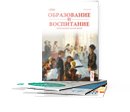Speaking is a core language skill that requires both linguistic competence and cognitive processing. Despite its importance, many learners face challenges in achieving oral fluency due to traditional grammar-focused instruction, limited speaking opportunities, and psychological barriers such as anxiety and low confidence. In Kazakhstan’s multilingual education system, fostering oral proficiency demands a shift toward communicative teaching methods, pronunciation training, and technology-assisted learning. By creating an interactive and supportive learning environment, educators can enhance students’ speaking skills and empower them to communicate effectively in a foreign language.
Keywords: oral proficiency, language acquisition, communicative approach, pronunciation training, technology-assisted learning, speaking confidence.
Language serves as a fundamental means of communication, enabling individuals to convey and comprehend ideas through both spoken and written forms. Among the four core language skills, speaking is often regarded as the most crucial, as it facilitates direct interaction and effective expression. In this regard, Jeremy Harmer emphasizes that «speaking is the ability to speak fluently and presupposes not only knowledge of language features but also the ability to process information and language» [1]. This statement highlights the dual necessity of linguistic knowledge and cognitive processing in achieving oral proficiency.
However, it is important to note that oral skills do not develop in isolation; rather, they are interdependent with other language competencies, such as listening, reading, and writing. For instance, strong listening skills enhance pronunciation and fluency, while reading expands vocabulary and improves writing abilities [2].
In Kazakhstan, the educational system emphasizes multilingualism, promoting proficiency in Kazakh, Russian, and English [3]. Despite structured curricula, many learners struggle with oral proficiency due to factors such as limited exposure to authentic communication environments, traditional grammar-focused teaching methods, and insufficient speaking practice. Studies highlight the complexities of language modernization in Kazakhstan, emphasizing the need for more effective teaching approaches. To address these challenges, educators play a pivotal role in creating a learning environment that encourages participation, reduces anxiety, and provides ample opportunities for oral practice.
Mastering oral language skills in a foreign language is influenced by a combination of psychological, linguistic, pedagogical, and environmental factors. Understanding these elements is crucial for developing effective teaching strategies and fostering learner success.
Psychological aspects significantly impact learners' oral proficiency. Speaking anxiety, characterized by fear of making mistakes or negative evaluation, can hinder active participation in speaking activities. Taylor Bardell (2019) emphasizes the importance of addressing these anxieties to improve oral language skills. Additionally, motivation and self-efficacy play pivotal roles; learners with higher self-efficacy are more likely to engage in speaking tasks and persist through challenges. Douglas Fisher and Nancy Frey (2014) highlight that fostering a supportive learning environment enhances students' confidence and willingness to communicate.
Proficiency in vocabulary, pronunciation, and grammar is essential for effective spoken communication. Paul Nation’s Four Strands framework (2013) underscores the importance of balancing these elements to develop comprehensive language skills.
|
Linguistic Factor |
Impact on Oral Proficiency |
Source |
|
Vocabulary |
Expands learners’ ability to express ideas effectively and accurately. |
Nation (2013) |
|
Pronunciation |
Improves intelligibility and helps avoid misunderstandings. |
Celce-Murcia (2010) |
|
Grammar |
Enhances sentence accuracy and fluency in spontaneous conversations. |
Fisher & Frey (2014) |
Without a strong vocabulary, learners struggle to find appropriate words, leading to hesitation. Similarly, poor pronunciation can result in misunderstandings, while grammatical errors may affect fluency and coherence.
Teaching methodologies and the learning environment significantly influence oral language development. Diane Larsen-Freeman (2011) discusses the effectiveness of the Communicative Language Teaching (CLT) approach, which emphasizes interaction and real-life communication scenarios to enhance speaking skills.
Furthermore, classroom interactions that promote authentic language use, such as group discussions, debates, and collaborative projects, provide learners with practical speaking opportunities. The integration of technology, including language learning apps and online platforms, also offers additional avenues for practicing oral skills.
Engaging learners in communicative activities fosters practical language use. Role-plays, debates, and discussions simulate real-life situations, encouraging spontaneous speech and critical thinking. Larsen-Freeman (2011) emphasizes that these methods not only improve fluency but also build learners' confidence in using the language authentically.
Focused pronunciation practice is vital for intelligibility and effective communication. Techniques such as:
– Minimal pair exercises (e.g., ship vs. sheep) help learners distinguish similar sounds;
– Choral repetition reinforces intonation and stress patterns;
– The shadowing method, where learners mimic native speakers, improves fluency and articulation.
The use of technology in language learning provides flexible and interactive platforms to practice speaking. AI-driven speech recognition tools offer immediate feedback on pronunciation, while language learning applications provide structured speaking exercises. A study by Barnwal and Tiwary indicates that repeated reading using computer-assisted language learning tools enhances oral fluency and narrative production.
Additional technological strategies include:
– Online language learning platforms (e.g., BBC Learning English, Duolingo) to practice pronunciation;
– Podcasts, videos, and speech analysis tools to expose learners to native speech patterns;
– VR simulations to practice real-life conversations in immersive environments.
|
Challenge |
Solution |
Source |
|
Speaking anxiety and lack of confidence |
Create a supportive classroom environment and encourage gradual exposure to speaking tasks. |
Fisher & Frey (2014) |
|
Pronunciation difficulties |
Use phonetic training exercises and AI pronunciation tools. |
Celce-Murcia (2010) |
|
Limited speaking opportunities |
Increase peer interactions, group discussions, and real-life speaking tasks |
Larsen-Freeman (2011) |
|
Grammar-related fluency issues |
Focus on communicative grammar activities and implicit learning methods. |
Nation (2013) |
Mastering oral foreign language skills requires addressing psychological, linguistic, pedagogical, and environmental factors. By implementing interactive teaching methods, pronunciation training, and technology-assisted learning, educators can effectively enhance learners' speaking abilities. Overcoming challenges, such as speaking anxiety and limited practice opportunities, requires a supportive learning environment and continuous engagement in speaking activities.
Ultimately, consistent practice and meaningful communication are the key elements of language mastery. By fostering a communicative learning environment, educators can empower students to become confident and proficient speakers in a foreign language.
References:
- Bardell, T. Oral Language Skills and Learning Disabilities, 2019.
- Fisher, D., & Frey, N, Speaking and Listening in Content Area Learning Reading Rockets, 2014.
- Nation, P Learning Vocabulary in Another Language, 2013
- Larsen-Freeman, D Key Concepts in Language Learning and Language Education, 2014
- Celce-Murcia, M., Brinton, D. M., & Goodwin, J Teaching Pronunciation: A Course Book and Reference Guide, 2016
- Barnwal, S. K., & Tiwary, U. S. Analyzing Effect of Repeated Reading on Oral Fluency and Narrative Production for Computer-Assisted Language Learning , 2020.







